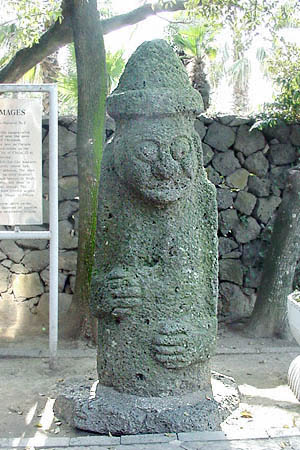Version 1: Samseong myth
 This myth tells of the first settlement on Cheju Island, located off the southern coast of the Korean Peninsula. In the beginning, before any people roamed the land, three demi-gods (Yangeulla, Koeulla, Pueulla) emerged from the ground. They wandered through the land and hunted, making clothes from the skins and subsisting on the meat.
This myth tells of the first settlement on Cheju Island, located off the southern coast of the Korean Peninsula. In the beginning, before any people roamed the land, three demi-gods (Yangeulla, Koeulla, Pueulla) emerged from the ground. They wandered through the land and hunted, making clothes from the skins and subsisting on the meat.The messenger announced that they had been sent from Byeongnang (some sources indicate that the messenger and girls came from Japan, which makes geographical sense). The king of that land had sent the girls to be the brides of the three demi-gods. After delivering his message, the messenger returned to his land on a cloud. The three demi-gods each married and went their separate ways, founding each their own village.
Source: http://www.pantheon.org
Version 2: Samseonghyeol myth
Located within Jeju City is where the history of Jeju Island began (designated Historic Site #134). According to legend, the three progenitors of the Jeju people emerged from three holes in the ground at this spot. To Jeju residents, it is more than legend and the event is described in the historical books ofSamkuksaki, Tongkuk-tongram, and Sejon Shilrok. The three caves where the men emerged was called ohonghyol. The names of the three god-men were Ko-ulla, Yang-ulla, and Pu-ulla. They hunted, wore leather clothes, and ate meat as their main food.
One day, they found a wooden box sealed with purple clay floating on the sea. When they opened the box, a messenger in purple clothes and a red belt came out. He spoke to the three men: “I am a messenger from the Byokrang state. Our king told his three daughters that there were three men of god who wished to find a new country on the western seashore. Go there and marry them.” The messenger then flew away on a cloud. Also inside the wooden box was a stone box. When it was opened, three girls in blue dresses, and a calf, pony, and five kinds of seeds came out.
The god-men then founded the T’amna Kingdom. In 1526, during the reign of King Chungjong (r.1506-1544), Yu Su-tong (the governor of Jeju Island) had an alter, crimson gate, and wall erected around the holes and began offering spring and autumn memorial services. These services are still held along with a memorial service celebrating the founding of the Island.






























